| 1 | The ultimate death faker |
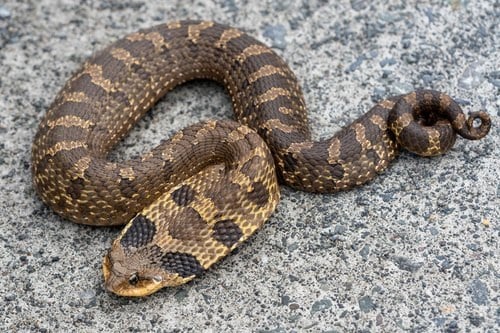
The eastern hognose snake (Heterodon platirhinos) is a harmless species that inhabits over 30 US states, plus southern Canada near Ontario. They have an extremely mild venom, and mainly inhabit areas of sandy soils which are easy to burrow in. Woodlands, spacious forests, beaches by lakes covered with woody debris, and sandy grasslands are their favourites, while they avoid agricultural land with a burning passion. This is the easterly form of the western hognose snake (Heterodon nasicus) and they also coexist with the rarer southern hognose snake (Heterodon simus), found in Florida and Georgia.
Eastern hognose snakes have one speciality: they’re the top death-faking snake of all 3900 species on Earth. This species has no real way to defend itself, against humans, birds, or wild turkeys (a common predator). So instead, they use spectacular acting skills and writhe on their back, flip over, loll out their tongue, and go completely still. They focus every ounce of concentration into convincing people they’re dead, until the predator they fear leaves the vicinity in disappointment.
Their routine is like an exaggerated death in an old 1950s western, full of over the top drama and flair. Grass snakes and Brazilian smooth snakes also play dead, but none have as elaborate a routine as Heterodon platirhinos.
| 2 | How to ID them |
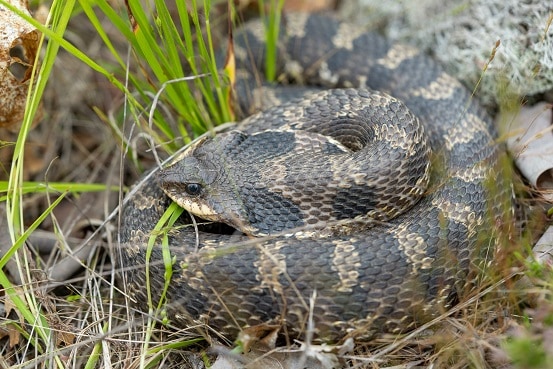
Eastern hognose snakes are found nowhere west of extreme eastern Colorado. They shun mammals and almost completely eat toads. In Canada for example, they have two main meals: Fowler’s toads (Anaxyrus fowleri) and American toads (Anaxyrus americanus), while in New York they add eastern spadefoot toads (Scaphiopus holbrookii). Juveniles will also feed on spring pepper frogs and redback salamanders.
Among the three US cousins, the most obvious difference is that eastern hognose snakes have the straightest nose. There’s still a noticeable point, but it faces directly forward. In western and southern hognose snakes, the namesake nose points vertically upwards, giving their face a more squashed effect (western pic).
Southern hognose snakes have a far paler belly than the eastern, which is largely patterned with black, and only becomes consistently pale at the tale. At a record of 115.5cm versus 100.6cm, eastern hognose snakes are also longer than their western cousin. Southern hognose snakes max out at a mere 61.0cm.
| 3 | Pulls out all the stops |
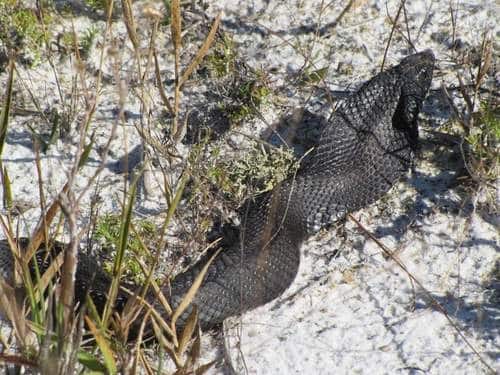
The eastern hognose snake’s bizarre death-faking ritual has been known for centuries. Just recently though, scientists have started to get technical. For example, this exhaustive review covered dozens of snakes across the Americas confirmed to fake their own death. It created a glossary of 14 behaviours that snakes can exhibit during this deception. No snake used all, and a handful used just one or two. A couple used 7 behaviours: western hognose snakes and the Dunn’s road guarder of Honduras.
But the snake to use the most was the eastern hognose snake, covering 8 in total, coming top of the pile in the western hemisphere. The technical terms were…
Tongue protrusion – a tongue sticking out is an instantly recognisable sign of death, and Heterodon platirhinus tries to exploit this for its deceptive games.
Contortion – the most infamous trick which everyone can see. Eastern hognose snakes writhe and thrash as though in final death throes.
Supination – the technical term for flipping onto one’s back. This comes after the contortion.
Defecation – the most disgusting trick they use. Heterodon platirhinus adds to the foulness by rolling in it, spreading it everywhere.
Mouth-bleeding – blood spewing from the mouth should trick a predator into thinking it’s dead, and Heterodon platirhinus does this spontaneously, without an actual wound. Also practised by the European dice snake.
Brachycardia – a significantly slowed heart rate. This might be important if a predator actually picks them up.
Tonic immobility – complete stillness and floppiness, as though completely dead.
Cloacal extrusion – grotesquely expanding its private parts, a sight nobody wants to see.
| 4 | Mindlessly grabs its prey |
Eastern hognose snakes are a clumsy hunter rather than a well-honed machine. They slither around their sandy-soiled woods patiently, and locate toads via tongue flecking. When they draw close, they simply charge at the toad with an open mouth, and snap shut when their teeth make contact.
If the toad inflates, then hognose snakes can still grip this rubbery balloon with their unusually enlarged front teeth. As with the western hognose snake, they have a Duvernoy’s gland which secretes an extremely mild venom from their rear fangs. This causes nothing more than stinging in humans, but is highly neurotoxic in amphibians, causing a complete neuromuscular blockade, blocking acetylcholine receptors in muscle cells, similarly to a black mamba’s paralysis in mammals. The toad’s muscle twitch amplitude was significantly lessened, while in guinea pig and rat tissue, the effect was far milder.
When injected into mice, they became hyperactive and then lethargic, but only experienced “minor, transient signs of toxicity“. Overall, none of the mice died, while 15 out of 17 frogs/toads died, following a simple venom injection. A blue-spotted salamander also survived. The eastern hognose snake is a highly specialised toad hunter.
| 5 | Immune to toad toxins, but why? |
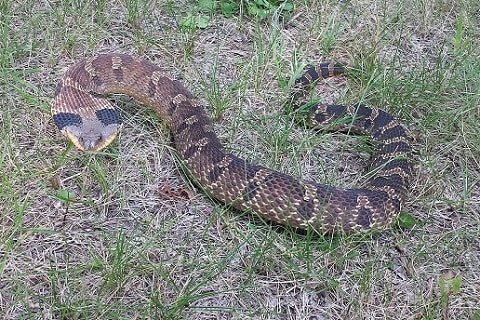
Like their western cousin, eastern hognose snakes are resistant to the heart-stopping bufotoxins found in amphibians. Most snakes crawl away and die after swallowing poisonous newts or toads, but Heterodon platirhinus slows down a little, digests, then reactivates and slithers away. A study found that even the smallest eastern hognose snakes could eat eastern newts (Notophthalmus viridescens) without succumbing. This amphibian forms one of their main prey outside of toads.
The scientists then analysed the snake’s genetic makeup. They found no alteration in the SCN4A gene, which creates bufotoxin resistance in most resistant animals. In garter snakes, which are also tetrodotoxin resistant, SCN4A has 2 to 4 altered alleles. The eastern hognose snake clearly had a rarer, undiscovered mutation. That said, western hognose snakes are confirmed to unleash an enormous dose of adrenaline after swallowing poisonous toads, to counteract the heart rate slowdown. Maybe it’s this simple mechanism again, or maybe there’s a hidden mutation.
Sodium channels in heart tissue are the main target of bufotoxins, with SCN4A creating a resistant structure. The scientists speculated that eastern hognose snakes have a factor in their bloodstream which “grabs” bufotoxins instead, binding to them before they can ever reach the sodium channels. This bufotoxin resistance applies not just newts, but toads, their main prey.
| 6 | Hibernates in mole burrows |
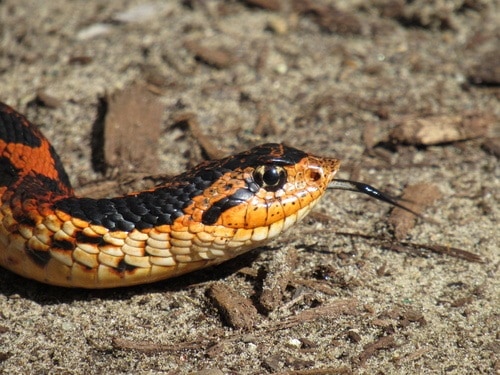
Eastern hognose snakes are capable, though not outstanding burrowers. Their strategy is to thrust their head deep into sandy soils, and wiggle from side to side until a tunnel is forged. They’ve occasionally been reported to forge their own hibernation dens like this. But a 1992-1994 study found differently. It tracked 13 eastern hognose snakes in a deciduous woodland in Arkansas, with several natural grassy open areas, and the occasional road and electricity pylon running through.
The snakes entered hibernation in mid-October and left in mid-April. Most importantly, they had a consistent tactic: every single one hibernated in a vacant burrow of an eastern mole (Scalopus aquaticus).
One male travelled 800 metres in 3 days to reach its mole burrow winter den, like it had suddenly remembered. The next year, it embarked upon another last minute journey: 700 metres in 2 days. The author excavated one burrow, and found the hognose snake 75cm deep from the entrance, and 25cm deep vertically. Their body temperatures averaged at 10.1C from Dec-Feb, although one hognose snake died after a cold snap where air temperatures plummeted to minus 6C. These snakes aren’t immune to the elements.
Copperheads prefer limestone cracks for hibernacula, sometimes sharing them with timber rattlesnakes, black racers and eastern ratsnakes. But eastern hognose snakes never appear in these cosy communal dens, preferring to hibernate singly.
| 7 | Extremely attuned to toad scents |
One consistent report from reptile enthusiasts is that eastern hognose snakes are much harder to feed than the western, as they eat toads far more strictly, while the latter is more flexible. 9 eastern hognose snakes were born between August 11th and 14th 2006. The mother had been collected 16km northwest of Tuscaloosa, Alabama. On August 23rd, these were shipped off to scientists at Fort Wayne, Indiana, who exposed them to various scents.
Despite never having eaten in their lives before, the hatchling hognose snakes flecked their tongues intensely when exposed to scents of the southern toad (Bufo terrestris). This was compared to a reptile, the green anole lizard, and a domestic cricket, collected from the same Alabama county.
With the lizard, they flecked their tongue barely any more than with the control substance (ionized water), while with the crickets, they showed a slight interest (1/4 that of the toads). The second most tongue flecking was piqued by tadpoles of the green frog (Lithobates clamitans), but this was far less intense than for southern toads.
| 8 | Uses scent rather than vision |
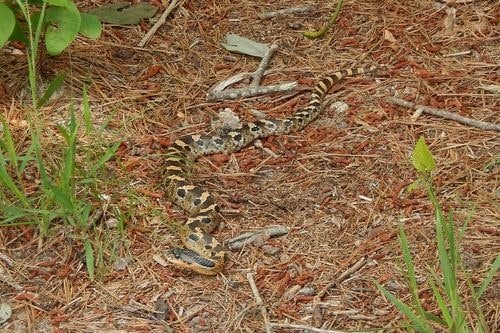
The species tested all coexist with eastern hognose snakes in the eastern US, so they are potential meals they would actually encounter. The taste for toads is coded into their genetics, and they know what do from birth.
Of all animal scents tested, Heterodon platirhonis only bit the swabs with toad scents, which happened twice. They were mildly interested in frog tadpole swabs, but never bit them. The scientists also used cologne, with a powerful smell, yet the hognose snakes didn’t care, proving that they differentiate scents down to a fine level.
In the study, the eastern hognose snakes also made defensive moves like flattening their heads, and mock lunges or strikes. These were stimulated solely by scent swabs, not live animals, so it seems that this snake relies heavily on scents even for self defence. If they’d used visuals, they would have clearly seen that no actual predator was nearby. The least tongue flecking of all was provoked by worm scents, and second last was mouse scents.
| 9 | Ignores mice in the wild |
Keepers testify that making this species eat the pinkie mice which corn snakes gobble up is almost impossible, requiring heavy trickery and scenting with amphibian odours. If raised from birth, they can be persuaded, but eastern hognose snakes fed a mouse diet tend to develop liver issues as well. Those captured from the wild can be impossible to persuade. Sometimes they’ll chew pinkie mice for a moment, holding them sideways in their mouth, before giving them up and burying them in their terrarium bedding.
Birds are also a pitfall. A report from 2004 saw an eastern hognose snake swallow an adult northern mockingbird, in Lake County, Florida. The snake was brought into captivity, but two days later, it regurgitated the bird and died.
Eastern hognoses may even give up their play dead antics in captivity, possibly after growing accustomed to their owner. This guy was disappointed that he hadn’t seen the routine for a full year.
| 10 | Frightened of paved roads |
Eastern hognose snakes swallow their prey alive, unlike a Malabar pitviper, which always waits for them to die. In fact, the luckiest toads can survive their stomach. In July 2004, a Heterodon platirhinos was being measured when it regurgitated an eastern spadefoot toad, which survived for 42 days in captivity, before being released back into the wild. In May 2005, an eastern hognose snake regurgitated a Fowler’s toad, which was completely healthy and released after 12 hours. It’s possible to be swallowed by this snake and live to tell the tale.
Eastern hognose snakes are sometimes killed on roads, but seem relatively resistant. Researchers examined a 5 metre wide, lightly paved road, only occasionally used by traffic. They were tracking 7 eastern hognose snakes over 4 years, and 4 of the snakes reached the roads, arriving 61 times overall. However, they only crossed the road in 15% of cases. In the rest, they reversed course or slithered parallel to the road. The researchers concluded that eastern hognose snakes were “sensitive to the presence of paved roads“, which is good if they want to avoid becoming roadkill like the gopher snake. A similar study from Ontario tracked 17 eastern hognose snakes, and found that while they happily crossed sandy roads, they instinctively avoided paved roads.
This is an active snake that regularly moves 100 metres in one day. Over an active season, they can move 5km from point to point on a map, and even longer considering the zigzagging, elaborate routes they take. They don’t move especially quickly, but grind onwards steadily. Another skill they have is flattening their neck like a cobra to look larger, though usually with their neck close to the ground.